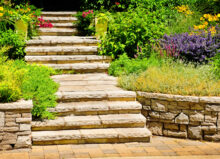Lawn Maintenance Guide: Prepping Your Landscape for the Fall & Winter
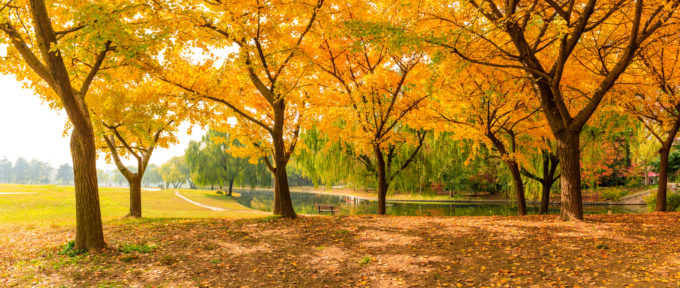
It’s that time of year again when most Michigan homeowners are starting to prep their landscaping and hardscaping for the fall and winter seasons. Have you started yet? If not, you’ll want to do it soon.
In this edition of our ongoing lawn maintenance series, we cover everything you need to do to keep your yard healthy and lush.
1. Bag Up, Mulch, or Compost Fallen Leaves
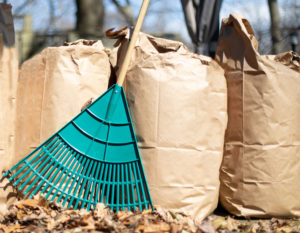
Before you start any work on your lawn, you’ll want to prioritize removing debris. Yes, it can be time-consuming, but it’s step one in maintaining a healthy lawn. It’s a myth that leaving fallen leaves in your yard is beneficial. It isn’t. A heavy layer of leaves will block the light, trap moisture, suffocate your grass, and could throw off the pH balance. So bag up, mulch, or compost all those fallen leaves. Your lawn will thank you! Additionally, you’ll want to remove any thatch that is thicker than an inch, otherwise it will attract insects. You will need a dethatching tool to perform this task.
2. Aerate Your Lawn
After removing all debris, you’ll want to aerate your lawn. You’ll want to buy or rent a core aerator for this task, or purchase lawn aeration shoe attachments. An aerator (and aeration shoe attachments) essentially open up small holes in your yard. These holes loosen up the soil, ensuring that your grass gets the water, oxygen, and nutrients it needs to thrive.
3. Apply Weed- & -Feed Fertilizer
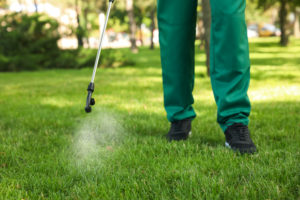
After aerating your lawn, you’ll want to apply a nitrogen-rich weed-and-feed fertilizer spray. As the name suggests, this spray has two functions: killing weeds and providing nutrients to your grass. Weeds will continue to grow throughout the fall. Although many may die during the first freeze, some weeds are hardy and will continue to grow. Weeds prevent soil from soaking up nutrients that your grass needs, so it’s best to eliminate weeds as soon as possible.
Additionally, it’s best to fertilize your lawn after you’ve aerated it because it helps the nutrients in the fertilizer get down deeper into the soil.
4. Overseed Your Yard
Next, you’ll want to overseed your yard; this can be done either before or after you’ve applied fertilizer, but it’s best to do it after aerating. Overseeding involves spreading grass seeds across your lawn and then watering it.
It’s important to overseed because most lawns experience damage during summer droughts and during the spring when moles and voles are the most active. Overseeding will help fill in bare spots and give you a denser lawn that provides some protection against weeds.
Additionally, be sure you’re purchasing the right type of grass seeds. According to Michigan State University, the best type of varieties include Kentucky bluegrass, perennial ryegrass, tall fescue, and fine fescue.
5. Keep Mowing Your Lawn
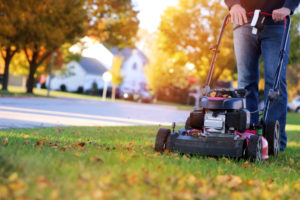
You should keep mowing your lawn until the first frost. It’s best to keep the length around two-and-a-half to three inches in height. If you allow it to get too long, it could potentially clog up your lawn mower and damage your lawn. Cutting it too short can also be detrimental, as it makes it harder for your grass to soak up the nutrients it needs.
6. Water Your Lawn
In addition to mowing, you’ll also want to keep watering your lawn. Grass continues to grow in the fall until the first hard freeze. Don’t just rely on the rain! Autumn can also have bouts of no rain. Ideally, your lawn should get one inch or more of moisture each week. If it’s not getting that, then you will need to adjust your watering schedule. You could also invest in a sprinkler system, which can help you save both time and money.
7. Maintain Pest Control
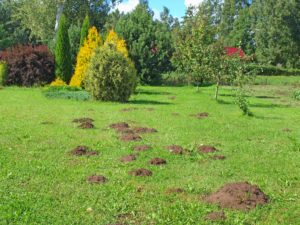
Watering and mowing won’t keep insects at bay, and if you don’t deal with them, they will continue to create problems for your lawn come spring. It’s best to identify any pests you have and apply a pesticide in the early fall to help eliminate those lawn pests now. Some of the most common lawn pests include billbugs, grubs, and sod webworms. Please note that if you applied pesticide in the spring, you may not need to reapply it in the fall. Be sure to check the instructions on the back of the bag, as some pesticides have year-round effects.
8. Remove Summer Annuals & Prune Plants
Your lawn isn’t the only part of your landscape that needs maintenance. Be sure to take care of your garden too! That means removing annuals and pruning plants as needed.
Annuals are just that—annual. They only grow for one season and then die off. So you will need to remove all annuals. For perennials, cut back any dead or wilted stems. Doing this will ensure your yard looks great during the winter and is ready for planting in the spring.
9. Stick to a Lawn Care Maintenance Schedule
All of these lawn care maintenance steps should be performed every year like clockwork. There’s a reason for this. If you wait until winter to fertilize, your soil won’t be able to absorb the nutrients it needs. And, if you aerate while it’s still hot outside, your efforts won’t be as effective.
Maintaining a strict lawn maintenance schedule is critical to maintaining a healthy lawn. If you don’t have the time to perform these fall lawn care maintenance tasks yourself, hire a professional to do it for you. The important thing is that it gets done as scheduled.
10. Inspect Hardscape Elements
Lastly, landscape maintenance isn’t just about preparing your lawn for the winter, it also includes preparing your hardscape elements as well. The winter can do just as much damage to your hardscape elements as it can to your lawn.
Maintaining hardscaping involves removing leaves and other debris from your pavers, walkways, and driveways, as well as ensuring your pavers are still in place. Paver joints are prone to shifting and that movement is more prevalent after freeze and thaw cycles. You should allow for the proper runoff while minimizing insects and weeds on your pavers. Additionally, always be sure to remove snow from your paver surfaces, otherwise, it will turn to ice which could damage them. Just make sure you use a rubber plate guard on the tip of your snow shovel and other equipment to prevent damage.
Get More Tips from Design One
If you are interested in more lawn maintenance, landscape or hardscape tips, or landscape design help for your home, turn to Design One. We provide a full line of hardscape and landscape design services to homeowners and businesses in Michigan. Contact us today to learn more about how we can help you.
As a residential and commercial landscaping company in Michigan, we’re experienced in both property care and landscaping design. With over 40 years of experience in the industry, Design One is great source of information when it comes to your Michigan lawn care needs! From preliminary design mapping, to irrigation and the types of plants you might want on your priority, we cover it all.

